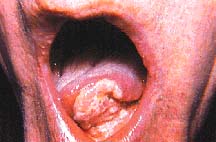 1. The scientific evidence is strong that the use of smokeless
tobacco can cause cancer in humans. The association between smokeless tobacco use and
cancer is strongest for cancers of the oral cavity.
1. The scientific evidence is strong that the use of smokeless
tobacco can cause cancer in humans. The association between smokeless tobacco use and
cancer is strongest for cancers of the oral cavity. Using Smokeless Tobacco is gambling with your health!
Smokeless "Spit" tobacco contains over 2,000 chemicals, many of which have been directly related to causing cancer. Here are a few photos of mouth problems caused by the reaction of tobacco in the mouth. Photos courtesy of A.Christen, Indiana University. Source of information: US Surgeon General Report, 1986
Carcinogensis Associated With Smokeless Tobacco Use
 1. The scientific evidence is strong that the use of smokeless
tobacco can cause cancer in humans. The association between smokeless tobacco use and
cancer is strongest for cancers of the oral cavity.
1. The scientific evidence is strong that the use of smokeless
tobacco can cause cancer in humans. The association between smokeless tobacco use and
cancer is strongest for cancers of the oral cavity.
2. Oral cancer has been shown to occur several times more frequently among snuff dippers than among nontobacco users, and the excess risk of cancers of the cheek and gum may reach nearly fifty-fold among long-term snuff users.
3. Some investigations suggest that the use of chewing tobacco also may increase the risk of oral cancer.
4. Evidence for an association between smokeless tobacco use and cancers outside of the
oral cavity in humans is sparse. Some investigations suggest that smokeless tobacco users
may face increased risks of tumors of the upper digestive tract, but results are
currently inconclusive. 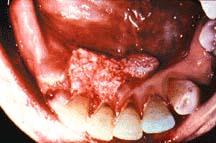
5. Experimental investigations have revealed potent carcinogens in snuff and chewing tobacco. These include nitrosamines, polycyclic aromatic hydrocarbons, and radiation-emitting polonium. The tobacco-specific nitrosamines N-nitrosonornicotine and 4-(methylnitrosamino)-1-(3-pyridyl -l-butanone have been detected in smokeless tobacco at levels 100 times higher than the regulated levels of other nitrosamines found in bacon, beer, and other foods. Animals exposed to these tobacco-specific nitrosamines, at levels approximating those thought to be accumulated during a human lifetime by daily smokeless tobacco users, have developed an excess of a variety of tumors. The nitrosamines can be metabolized by target tissues to compounds that can modify cellular genetic material.
6. Bioassays exposing animals to smokeless tobacco, however, have generally shown little or no increased tumor production, although some bioassays suggest that snuff may cause oral tumors when tested in animals that are infected With herpes simplex virus.
Noncancerous and Precancerous Oral Health Effects Associated With Smokeless Tobacco Use
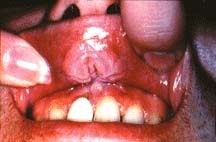 1. Some snuff-induced oral leukoplakic
lesions have been noted upon continued smokeless tobacco use to undergo transformation to
a dysplastic state. A portion of these dysplastic lesions can further develop into carcinomas
of either a verrcous or squamous cell variety.
1. Some snuff-induced oral leukoplakic
lesions have been noted upon continued smokeless tobacco use to undergo transformation to
a dysplastic state. A portion of these dysplastic lesions can further develop into carcinomas
of either a verrcous or squamous cell variety.
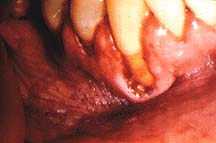 2. Recent studies of the effects of smokeless tobacco use on
gingival and periodontal tissues have resulted in equivocal findings. While gingival
recession is a common outcome from use, gingivitis may or may not occur. Because
longitudinal data are not available, the role of smokeless tobacco in the development and
progression of gingivitis or periodontitis has not been confirmed.
2. Recent studies of the effects of smokeless tobacco use on
gingival and periodontal tissues have resulted in equivocal findings. While gingival
recession is a common outcome from use, gingivitis may or may not occur. Because
longitudinal data are not available, the role of smokeless tobacco in the development and
progression of gingivitis or periodontitis has not been confirmed. 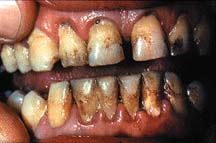
3. The evidence concerning the effects of smokeless tobacco use on the salivary' glands is inconclusive.
Nicotine Exposure: Pharmacokinetics, Addiction, and Other Physiologic Effects
l. The use of smokeless tobacco products can lead to nicotine dependence or addiction.
2. An examination of the pharmacokietics of nicotine (i.e., nicotine absorption, distribution, and ellimination) resulting from smoking and smokeless tobacco use indicates that the magnitude of nicotine exposure is similar for both.
3. Despite the complexities of tobacco smoke self-administration, systematic analysis has confirmed that the resulting addiction is similar to that produced and maintained by other addictive drugs in both humans and animals. Animals can learn to discriminate nicotine from other substances because of its effects on the central nervous system. These effects are related to the dose and rate of administration, as is also the case with other drugs of abuse.
4. It has been shown that nicotine functions as a reinforcer under a variety of conditions. It has been confirmed that nicotine can function in all of the capacities that characterize a drug with a liability to widespread abuse. Additionally, as is the case with most other drugs of abuse, nicotine produces effects in the user that are considered desirable to the user. These effects are caused by the nicotine and not simply by the vehicle of delivery (tobacco or tobacco smoke).
5. Nicotine is similar in all critical measures to prototypic drugs of abuse such as morphine and cocaine. The methods and criteria used to establish these similarities are identical to those used for other drugs suspected of having the potential to produce abuse and physiologic dependence. Specifically, nicotine is psychoactive, producing transient dose-related changes in mood and feeling. It is a euphoriant that produces dose-related increases in scores on standard measures of euphoria. It is a reinforcer (or reward, in both human and animal intravenous self-administration paradigms, functioning as do other hags of abuse. Additionally, nicotine through smoking produces the same effects, and it causes neuroadaptation leading to tolerance and physiologic dependence. Taken together, these results confirm the hypothesis that the role of nicotine in the compulsive use of tobacco is the same as the role of morphine in the compulsive use of opium derivatives or of cocaine in the compulsive use of era derivatives.
6. The evidence that smokeless tobacco is addicting includes the pharmacologic role of nicotine dose in regulating tobacco intake; the commonalities between nicotine and other prototypic dependence-producing substances; the abuse liability and dependence potential of nicotine; and the direct, albeit limited at present, evidence that orally delivered nicotine retains the characteristics of an addictive drug.
7. Several other characteristics of tobacco products in general, including smokeless tobacco, may function to enhance further the number of persons who are afflicted by nicotine dependence: nicotine-delivering products are widely available and relatively inexpensive; and the self-administration of such products is legal, relatively well tolerated by society, and produces minimal disruption to cognitive and behavioral performance. Nicotine produces a variety of individual-specific therapeutic actions such as mood and performance enhancement; and the brief effects of nicotine ensure that conditioning occurs, because the behavior is associated with numerous concomitant environmental stimuli.
8. All commonly marketed and consumed smokeless tobacco products contain substantial quantities of nicotine. The nicotine is delivered to the central nervous system in addicting quantities when used in the fashion that each form is commonly used (or as recommended in smokeless tobacco marketing campaigns).
9. Since the exposure to nicotine from smokeless tobacco is similar in magnitude to nicotine exposure from cigarette smoking, the health consequences of smoking that are caused by nicotine also would be expected to be hazards of smokeless tobacco use. Areas of particular concern in which nicotine may play a contributory or supportive role in the pathogenesis of disease include coronary artery and peripheral vascular disease, hypertension, peptic ulcer disease, and fetal mortality and morbidity.
Smokeless Tobacco Is Less Risky Than Smoking, though still dangerous. Some other effects are:
TOOTH ABRASION - Grit and sand in smokeless tobacco products scratches teeth and wears away the hard surface or enamel. Premature loss of tooth enamel can cause added sensitivity and may require corrective treatment.
GUM RECESSION - Constant irritation to the spot in the mouth where a small wad of chewing tobacco is placed can result in permanent damage to periodontal tissue. It also can damage the supporting bone structure. The injured gums pull away from the teeth, exposing root surfaces and leaving teeth sensitive to heat and cold. Erosion of critical bone support leads to loosened teeth that can be permanently lost.
INCREASED TOOTH DECAY - Sugar is added to smokeless tobacco during the curing and processing to improve its taste. The sugar reacts with bacteria found naturally in the mouth, causing an acid reaction, which leads to decay.
TOOTH DISCOLORATION AND BAD BREATH - Common traits of long-term smokeless tobacco users are stained teeth and bad breath. Moreover, the habit of continually spitting can be both unsightly and offensive.
NICOTINE DEPENDENCE - Nicotine blood levels achieved by smokeless tobacco use are similar to those from cigarette smoking. Nicotine addiction can lead to an artificially increased heart rate and blood pressure. In addition, it can constrict the blood vessels that are necessary to carry oxygen-rich blood throughout the body. Athletic performance and endurance levels are decreased by this reaction.
UNHEALTHY EATING HABITS - Chewing tobacco lessens a person's sense of taste and ability to smell. As a result, users tend to eat more salty and sweet foods, both of which are harmful if consumed in excess.
ORAL CANCER - With the practice of "chewing" and "dipping," tobacco and its irritating juices are left in contact with gums, cheeks and/or lips for prolonged periods of time. This can result in a condition called leukoplakia. Leukoplakia appears either as a smooth, white patch or as leathery-looking wrinkled skin. It results in cancer in 3 percent to 5 percent of all cases.
OTHER CANCERS - All forms of smokeless tobacco contain high concentrations of cancer-causing agents. These substances subject users to increased cancer risk not only of the oral cavity, but also the pharynx, larynx and esophagus.
DANGER SIGNS - If you use smokeless tobacco, or have in the past, you should be on the lookout for some of these early signs of oral cancer:
* A sore that does not heal
* A lump or white patch
* A prolonged sore throat
* Difficulty in chewing
* Restricted movement of the tongue or jaws
* A feeling of something in the throat
Pain is rarely an early symptom. For this reason, all tobacco users need regular
dental check-ups.
If it's time for you to quit, try Mint Snuff Non-Tobacco Chew!
Try New Mint Snuff Pouches For
$1!